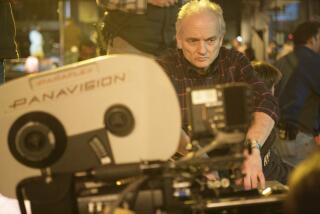Before âSeinfeldâ became âSeinfeldâ
Since âSeinfeldâ went off the air in 1998, the showâs co-creators, Jerry Seinfeld and Larry David, have remained idiosyncratically true to their artistic selves. Seinfeld the polished comedian returned to stand-up and buried his old act in an HBO special, âIâm Telling You for the Last Time,â then built up new material and filmed that process too, in the 2002 documentary âComedian.â Just as Seinfeld played the comedian Jerry Seinfeld in âComedian,â David is now playing the dyspeptic âSeinfeldâ co-creator Larry David in âCurb Your Enthusiasm,â the HBO series that begins production for a fifth season in January.
What Seinfeld and David continue to say about themselves as artists is that theyâre micro-view people. They donât have anything big to say about politics or art or even comedy, just little side observations based on what they did today or yesterday or the day before. Thatâs their comfort zone. Thatâs a show.
And so it comes as no surprise that âThe Seinfeld Story,â a one-hour special airing at 10 p.m. Thanksgiving on NBC, is not a grand thing, not a retrospective or a reunion show or anything that might reek of self-examination. Itâs more a window onto a great sitcomâs accidental beginnings, not to mention a promotional push for the DVD of the first three seasons, which Columbia TriStar Home Entertainment released Tuesday, in the thick of the holiday season.
The special, edited from material on the DVD, makes no attempt to analyze what âSeinfeldâ meant to popular culture. Nor is it feel-good or wistfully nostalgic: Cast members Jason Alexander, Michael Richards and Julia Louis-Dreyfus appear on screen, but not together in anything resembling a group hug.
Like an episode of VH1âs âBehind the Musicâ or an âE! True Hollywood Storyâ without the madness, drugs and the stock shot of an ambulance, âThe Seinfeld Storyâ follows the showâs early progression from failed pilot to full-fledged series. Though itâs by now a familiar story, the showâs beginnings remain remarkable. Networks seldom do what NBC inadvertently did with âSeinfeldâ -- left it on the air to find its voice. The special relives this lore: How after getting dumped on the air as a failed pilot, the show was kept on life support by NBCâs Rick Ludwin, who gave up two hours of his specials budget so that four more episodes could be made. âI have to say, my initial reaction was not joy,â David says. The four episodes led to an order for 13 more in 1991 (David: âI couldnât believe it; this thing now is getting much bigger than it was supposed to ... â), which became a full order for 22 more (David: âI cried on my bed at the prospect of coming up with 22 more of these thingsâ). Along the way, âSeinfeldâ was regarded inside the network as quirky but plot-less, an oddity. Nowadays it would be canceled, quickly, without a fruit basket.
But itâs also too easy to say that all shows should be given the second and third chances âSeinfeldâ got. Seen today, the early episodes, even the now-classic âChinese Restaurant,â feel slow and somewhat hesitant -- baby steps in an unlikely evolutionary process that would eventually make âSeinfeldâ one of the most creatively innovative and lucrative sitcoms ever. (In syndication, âSeinfeldâ has grossed what those in the entertainment industry refer to as ânorth of a billionâ dollars.)
Indeed, most long-running sitcoms donât change as significantly as âSeinfeldâ did during its eight-year run on NBC. As initially conceived, âSeinfeldâ was nominally supposed to be a show about how a stand-up comedian gets his material. The early episodes intersperse one or two light plot devices (Jerryâs grown sick of an old friend but wonders how to break up with a guy), with Seinfeld the comedian commenting on the action in his act.
From this template, of course, grew something much zanier, darker and freer. In the special, Seinfeld traces the âaha!â moment to an episode in which George has to save a whale and Kramerâs been hitting golf balls at the beach. âAnd we thought, wouldnât it be great if it were Kramerâs golf ball that had gotten stuck in the blowhole of the whale. Can we do that? Should we do that?â By its latter seasons, âSeinfeldâ was juggling four or five storylines, not two, and came up with increasingly loony ways to illustrate its characters arrested development. David left in 1995 and came back for the final episode, in which Jerry, George, Kramer and Elaine, finally, are left sitting in a prison cell. This was âSeinfeldâsâ final plot twist: Those characters weâd been enjoying all those years, these people weâd embraced as our own, were in fact social criminals.
It seems telling that NBC has to turn to one of its old shows to get ratings on a night when American families, gorged on turkey and various complex carbohydrates, are sure to be camped in front of their TV sets.
That pieces of the special are included in the DVD package makes this particular television event a kind of infomercial -- and unintentionally a program that betrays how far NBCâs Thursday night âMust See TVâ lineup, which âSeinfeldâ once anchored, has fallen.
*
âThe Seinfeld Storyâ
Where: NBC
When: 10 to 11 p.m. Thursday
Rating: TV-14 (may be unsuitable for children under the age of 14)
Executive producers Jerry Seinfeld, George Shapiro, Howard West.
More to Read
The complete guide to home viewing
Get Screen Gab for everything about the TV shows and streaming movies everyoneâs talking about.
You may occasionally receive promotional content from the Los Angeles Times.






